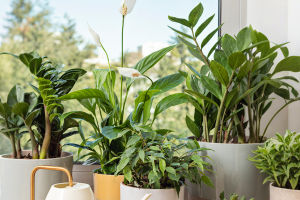Have you ever wondered what your houseplants are up to when you're not looking? While we tend to think of plants as silent, stationary beings, they are anything but.
In fact, plants have a fascinating way of communicating with each other, with animals, and even with us! You might be surprised to learn that plants have senses and strategies that go far beyond photosynthesis and growth.
In this article, we'll take you on a journey through the hidden world of plant communication. It's not just science fiction; plants actually "talk" to each other in ways that can influence everything from their growth to their survival. Let's dig in!
Plants Have Their Own Senses
First things first—plants are not the passive, unaware organisms we might assume. They have highly developed senses, even though they don't have eyes or ears like animals do. They can perceive light, gravity, touch, and even chemicals in the air. But how do they communicate? It turns out that plants use a combination of chemical signals, electrical impulses, and physical changes to "talk" to each other.
Plants have specialized cells that respond to external stimuli. For example, when a plant feels a threat—like being grazed by a herbivore—it can release chemicals into the air or soil to warn nearby plants of the danger. This is similar to how we send a distress signal when we need help. In a sense, plants are not isolated; they form a network of communication to protect one another.
The Role of Chemical Signals
One of the most well-known forms of plant communication is through chemicals. These are known as volatile organic compounds (VOCs), and they act like a plant's "warning signal." When a plant is under attack by pests, it can release specific VOCs into the air that tell nearby plants to prepare their defenses. Some plants even send out these signals to attract predatory insects that can help fight off the harmful pests.
For instance, when a tree is being eaten by insects, it can release a certain chemical that triggers the neighboring trees to ramp up their own defenses. This could mean producing chemicals that are toxic to the pests or enhancing their own physical defenses, like thorns.
These chemical signals can also be sent through the roots, creating an underground network of communication. It's like a hidden internet of plants, transmitting vital information from one root system to another.
Electrical Signals: The Plant Nervous System
While plants don't have a brain, they do have a sophisticated way of transmitting electrical signals through their cells. These signals are similar to the nerve impulses that travel through our bodies. For example, when a plant's leaves are touched, electrical signals move quickly from the point of contact to the rest of the plant. This allows the plant to respond almost instantly, like closing its leaves or releasing defensive chemicals.
Recent studies have also shown that plants use electrical signals to communicate with each other over long distances. When one plant experiences a stressful situation, it can send out electrical impulses that alert other plants to prepare for similar conditions. This mechanism helps plants adapt to changes in their environment and ensures their survival.
Plants and Animals: A Two-Way Conversation
Plants don't just talk to other plants; they also communicate with animals. One of the most well-known forms of this communication is through pollination. Flowers attract pollinators like bees, birds, and butterflies by emitting sweet scents and colorful patterns. These visual and chemical cues are specifically designed to grab the attention of the right pollinator.
But plants also use communication to defend themselves against herbivores. Some plants have evolved to produce chemicals that are toxic to animals, but they don't stop there. They can also send out chemical signals that attract animals that will help protect them. For example, when a plant is under attack, it might release a scent that attracts predatory insects that will feast on the herbivores attacking the plant.
This kind of two-way communication shows that plants are not just passive in their environment—they actively shape it to their advantage.
Plants Talk to Us, Too
So, what about us? Can plants communicate with humans? The answer is yes—sort of. While plants can't speak our language, they do send us signals through their growth patterns and physical appearance. Have you ever noticed how a plant seems to droop when it's thirsty or turns yellow when it's sick? These are subtle signals that plants send to indicate their needs.
Moreover, studies suggest that plants can respond to human interaction. Some research has shown that plants grow better when exposed to positive vibrations or even music. While the science is still up for debate, it's fascinating to think that plants may have an awareness of the world around them.
Conclusion: The Hidden World of Plant Communication
The world of plants is far more complex and dynamic than we often give it credit for. From chemical signals to electrical impulses and even interactions with animals and humans, plants are constantly communicating with their surroundings. Whether they're defending themselves from threats, attracting pollinators, or simply sharing information with each other, plants are engaged in a constant, secret conversation that we're only just beginning to understand.
Next time you water your plants or walk through a garden, take a moment to think about what might be happening beneath the surface. These silent, green life forms are more connected and aware than we ever imagined. Isn't it amazing that plants have their own hidden ways of "talking" to the world?
Let's keep the conversation going—share your thoughts or experiences with plant communication in the comments below!


